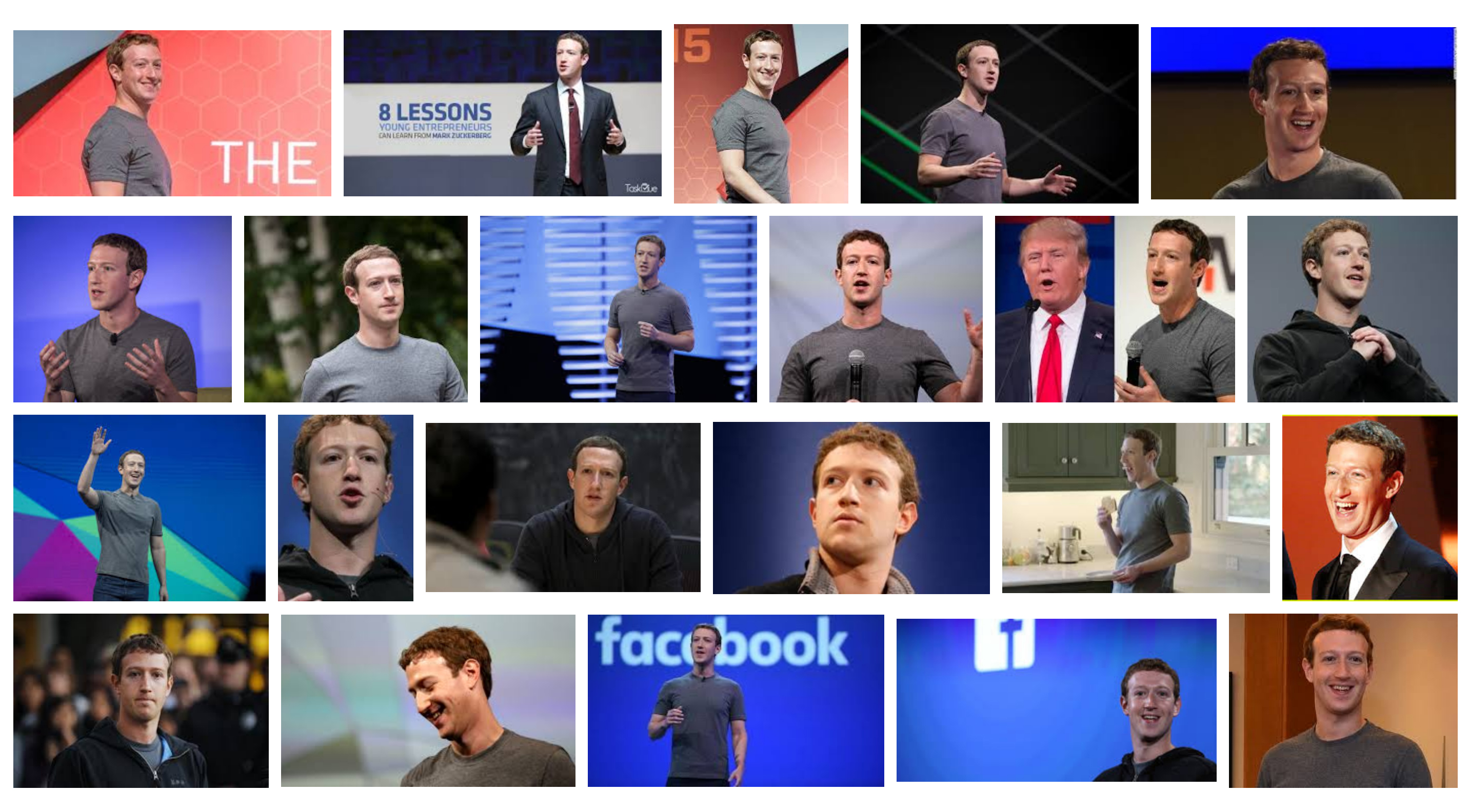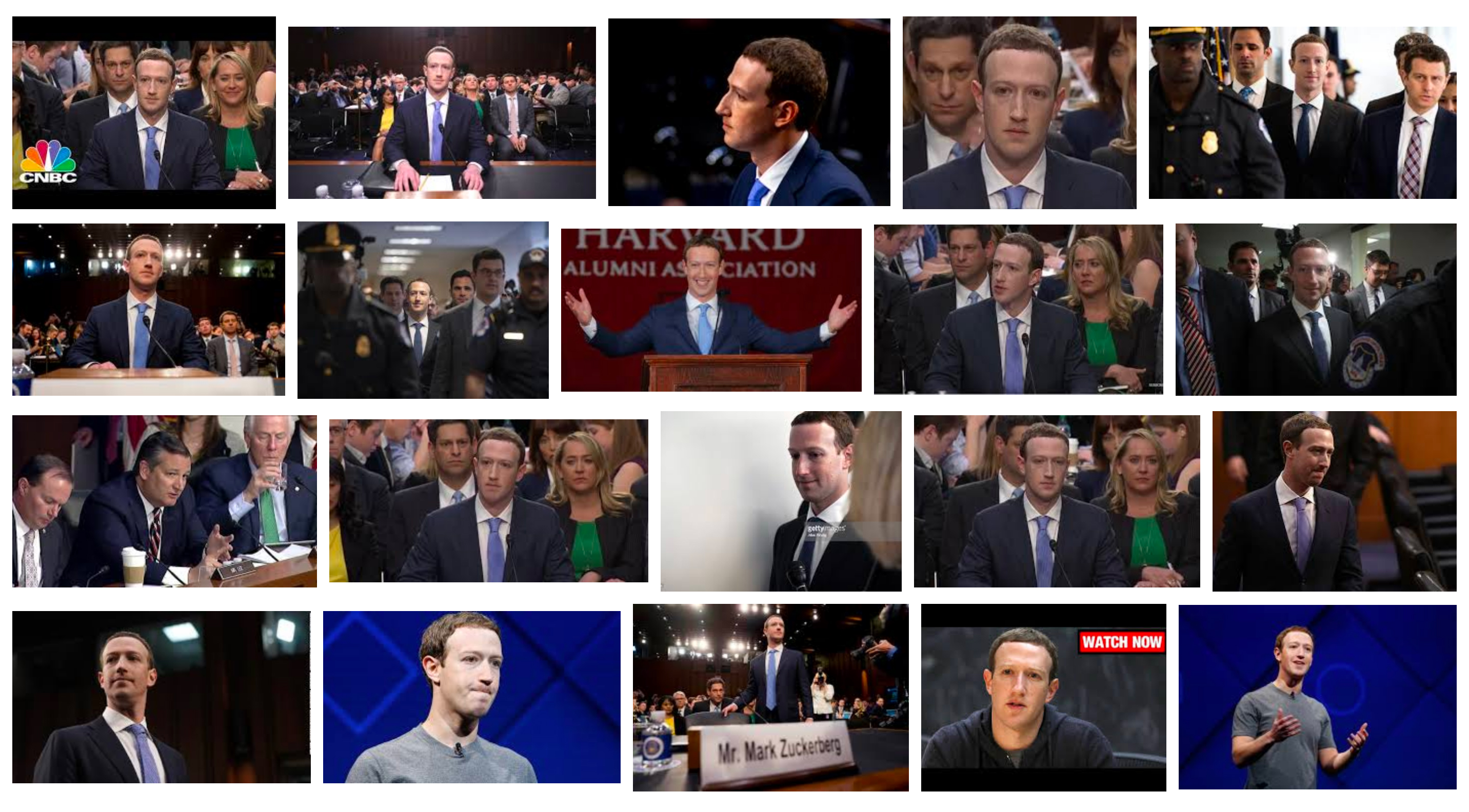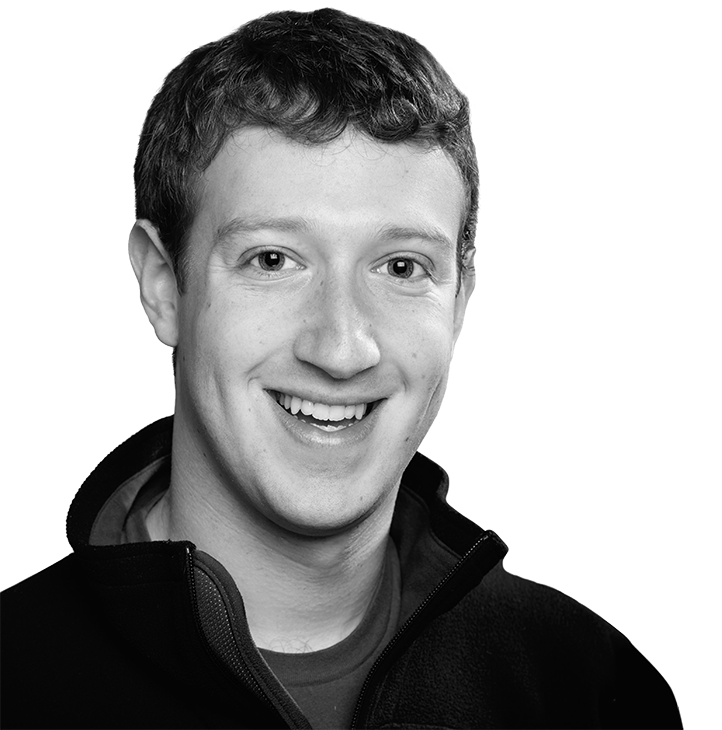
Source: Google Image Search - "Mark Zuckerberg" (June 19, 2018)
Visible Invisible Man



Mark Zuckerberg has a uniform: dark jeans and a plain gray t-shirt. An image search for the Facebook founder returns row after row of dark heather gray crewnecks, with the occasional hoodie or suit thrown in for variety. The visual sameness of Zuckerberg’s dress code is amplified by the fact that he is most often photographed against low-context backgrounds like conference stages, boardrooms, and slick corporate slide decks. Together, outfit and setting conspire to turn a specific person—Mark Zuckerberg, aging wunderkind—into an icon and a cypher. His boring consistency performs a sleight of hand that lets him, and his actions, hide in plain sight.
Self-defined uniforms are common among the tech founder set. Steve Jobs’ black mock-turtleneck and dad jeans remain famous even years after his death, and until her fall from grace, Theranos founder Elizabeth Holmes was lauded for her turtleneck and blazer uniform. Uniform dressing provides several obvious benefits: getting dressed in the morning takes a matter of seconds, you free up brain space to focus on more essential tasks like coding and hustling, and it keeps your shopping life simple—no need to worry about whether lapel sizes are waxing or waning when your wardrobe could be composed solely of Fruit of the Loom 10-packs. “I really want to clear my life to make it so that I have to make as few decisions as possible about anything except how to best serve this community” said Zuckerberg during his first ever public Q&A session in 2014.
The professed commitment to minimalism and practicality is an explanation (“I look like this on purpose") and a founder creation myth. In this way a carefully chosen biographic quirk functions as a world-building act, telegraphing Zuckerberg's self-aware anti-fashion seriousness while also adding another piece to the pile of building blocks that compose his public identity. His sartorial consistency has the significant secondary effect of creating a recognizable and consistent visual brand. While a gray tee may lack the panache of Colonel Sanders’ white suit and string bow tie or the Virgin Mary’s shroud, it has a similar function. By dint of repetition and wide distribution, the subject’s visual appearance approaches that of an icon: singular, unchanging, and instantly recognizable. In an age where tech CEOs are public figures whether they like it or not, becoming-iconic is a savvy business move.
An icon is bound by neither space nor time. Unchanging from one appearance to the next, the Virgin Mary and Colonel Sanders conjure meaning that accumulates and exceeds the bounds of any individual human. Icons are stripped of their historical specificity, “transformed into their own images” (Jameson 1990, p11) and pared down to one or two defining features. Che Guevara in a military beret, staring steadfastly towards a revolutionary future. Marilyn Monroe, all hourglass figure and lacquered platinum hair. Gray-clad Mark Zuckerberg, pale face framed by a scrappy Caesar cut fringe. Almost nothing about Zuckerberg’s appearance changes enough to give the game away. Future Facebook historians may be able to identify the period in which he switched barbers for a few months or tried out a new t-shirt brand, but for the layperson it’s hard to distinguish 2015 Zuck from 2017 Zuck. When you become an icon, your image does the symbolic work, leaving your body and brain to perform miracles or hack the future in peace.
Zuckerberg is often photographed in low context settings, which strip him further of any temporal or spatial specificity. As if by magic, but more likely by design, Zuckerberg is repeatedly shown speaking to an unseen audience, mic clipped to the front of his tee, a blue backdrop or minimal slidedeck providing a backlit blank slate. If it weren’t for the odd lectern, table or “fireside chat” interlocutor, many of the shots would be so strikingly similar they could in fact be from the same conference or presentation. Considering that a key aspect of Facebook’s business is hosting (and harvesting) photos from the lives of billions of people, it seems particularly jarring that images of the man in charge offer such little variety. But if we instead recognize Zuckerberg’s image as a free-floating brand mark, each blank-slate photograph makes sense as the headshot of an icon, alone in the near-empty frame.
Zuckerberg’s iconic low-context photographic existence is a direct repudiation of the logic of visual culture in the internet age, which desires visual novelty and endless variety. In a media era where news and gossip websites are updated multiple times a day, every Musk tweet or OS update becomes fodder for a raft of stories. The lack of visually distinct photographs of Zuckerberg is surely a frustration to the content-hungry news media, which must make do with an unexciting photo of low-context iconic Zuck, or turn to a designer to doctor up some visual excitement. Wired’s May 2018 cover features a portrait of Zuckerberg, digitally manipulated to look “beaten up” and “battle-torn”. This fantasia in tones of pink and blood red tweaks the standard gray t-shirt Zuckerberg portrait photo, adding a layer of pathos (or perhaps wish-fulfillment) to a familiar image. To accompany a recent story on The Verge, Zuckerberg's monochromed head and shoulders were placed over a vibrant background of red and white stripes. This jazzy background adds little in the way of context or meaning, but it does provide a visual respite from the dreary nothingness that usually surrounds Zuckerberg in public photographs.
This grim pictorial reality is unusual when it comes to public figures, who are usually expected to provide regular visual fodder via fresh outfits and public appearances. Instead, Zuckerberg’s nondescript photographic presence has closer parallels with a quandary faced by tech writers: how do you depict the physical infrastructure of the tech world? Pity the journalist who needs to illustrate a story about blockchain or a new piece of hardware. Faced with the prospect of illustrating another story about “Stingray" phone-spying devices with one of the few publicly available photos—a grainy image of a stubbornly dull grey machine—Gizmodo reporter Dell Cameron sent out a clarion call. "The biggest problem for journalists covering these devices is that it’s so damn hard to find a decent fucking picture of these things… We’re asking you, dear reader, to help create some new variations on this seemingly ancient image.” Without a specific illustration, the news becomes less concrete, less material. Is the Stingray really working covertly to surveil your phone calls? If you’ve never seen one in context, it’s hard to imagine. And if it’s hard to imagine, maybe it isn't worth discussing at all.
In the case of both Mark Zuckerberg and the Stingray, the paucity of distinctive or high quality images makes the thing itself seem more distant, and more boring. Being boring isn’t new to Mark Zuckerberg. Since the early days of Facebook, he’s taken pains to self-identify as such, and journalists have been happy to follow suit. “He’s worth $35.7 BILLION, so why is Mark Zuckerberg’s wardrobe SO boring?” inquires the Express. He dresses like “someone who’s in a rush to the gym” says one GQ columnist. Posting a photograph of his wardrobe full of identical fresh grey t-shirts and hooded sweatshirts, Zuckerberg asks his own Facebook followers “First day back after paternity leave. What should I wear?” The accompanying emoji-with-monocle and “feeling undecided” status drive home the joke: he’s boring and he knows it.
Being boring is not just an unfortunate side effect of being Mark Zuckerberg, it’s a strategy. As the evasive flipside of iconicity, the boring subject professes itself too dull to bother with. Look upon my Works, ye Mighty, and then... look away again because *yawn*. In fact, why look at Mark Zuckerberg at all, because you already know what you’re going to see. Daniel Radcliffe displayed his own canny mastery of boringness as evasion strategy during the period in which he was wrenching himself from the frenzied fandom of Harry Potter. Facing down a daily gauntlet of paparazzi as he left the theater where he was performing, Radcliffe would wear an identical outfit and hat every day, thwarting the photographers' ability capture a novel image. “They could take photos for six months but it would look like the same day”, he says. Photographs of Radcliffe, lacking the temporal or sartorial markers that the gossip rags would pay for, "became un-publishable,” allowing the actor to become, for a moment, the world’s most visible invisible man.
Zuckerberg’s boringness follows the same strategic maxim. Induce visual boredom, and no one wants to look at you. When no one wants to look at you, they don’t see what you’re doing. You become a slippery subject, better able to evade scandal, attention, or ire. The best criminal is the one that looks utterly unassuming. Days after Facebook settled Federal Trade Commission charges that it deceived consumers about their content privacy in November 2011, a cache of Zuckerberg’s personal photos were leaked due to a Facebook glitch. While this leak could have constituted more fuel for the privacy fire, instead the focus was on Zuckerberg’s photographic banality, with the Atlantic sharing this non-scoop: “Mark Zuckerberg’s Private Secret: He’s Boring”. The photographs are a snooze-fest, so the press moves its attention to the next big thing, allowing Zuckerberg and Facebook to continue operating with minimal scrutiny. The double move of becoming-icon and becoming-boring means that Zuckerberg avoids the dangers of time-bound visual specificity, while still functioning in the cultural imagination as a youthful gray-clad icon.

Source: Google Image Search - "Mark Zuckerberg April 2018" (June 19, 2018)
This history of evasive blandness has one clear exception. In April of this year, Mark Zuckerberg was called to testify in front of the United States Congress. The Cambridge Analytica scandal had broken, and concern about the scope and scale of personal data collection and sharing was reaching a fever pitch. As Facebook’s CEO-slash-icon, Zuckerberg was to account for Facebook’s business decisions and policy oversights, while also representing "the internet" in toto to a crowd of irascible lawmakers. Faced with such a high-stakes, high profile, appearance, Zuckerberg broke with sartorial tradition by appearing in a suit and tie.
In previous years, Zuckerberg has been happy to flaunt convention. In the lead-up to Facebook’s IPO launch, he attended a high-stakes investor meeting in a hoodie, a declarative moment and back-handed power move that “rankled Wall Street” but shored up Zuckerberg’s image as a iconoclastic Silicon Valley upstart. In contrast, news coverage of the Congressional hearing shows him in a boxy suit with a large-collared shirt and loosely knotted tie, lit by the flashbulbs of dozens of journalists. Dressed in the uniform of business, Zuckerberg’s usual studied casualness gives way to formality, and the boardroom or conference stage is switched out for the bureaucratic specificity of the Hart Senate Office Building. How unusual to see him shot from a high angle, perched on a booster cushion but still appearing small in his square-shouldered outfit amidst a crowd of aggressively suited congresspeople. No minimalist Facebook blue here.
In the history of Zuckerberg photography, images from the Congressional hearing feel uniquely weird. Roland Barthes talked about the “punctum”, a photographic moment or an object within a photograph that “rises from the scene, shoots out of it like an arrow, and pierces me” (26), puncturing the surface of the photograph with poignant specificity. It might be a torn shoe, an unusual glance, or an off-center figure—anything that hits the viewer with an unexpected pop. The punctum collapses the distance (of time, of space) between viewer and photograph, forces a portal between the two through which an affective state flows. Zuckerberg’s testimony to congress provides a sort of punctum in the photographic record. Scrolling through pages of image search results, the grey-clad timeless Zuck photos are intersected here and there by a boxy suit, a background scrum of congresspeople. For a second, Zuckerberg is time-bound and dreadfully immanent, and the viewer might think, for a second, to feel sorry for him.
Does the punctum of the congressional testimony mark a transition to a new mode of image-making for Mark Zuckerberg and Facebook? Will this suited moment wrench Zuckerberg from iconic obscurity, forcing him to account for himself, his appearance, and his public? It’s conceivable that Zuckerberg would take this opportunity to embrace a more conventional CEO aesthetic, befitting the status of a man rumored to be considering a career in politics. It’s also conceivable that the suit was deployed for the same strategic reasons as the usual gray t-shirt regimen. On balance, this seems likely. While his departure from the sartorial norm appears at first as a focus-pulling divergence, Zuckerberg’s strategy of maximizing visual boredom means that contextual camouflage takes precedence over maintaining consistency of his iconic uniform.
Congressional hearings are open to the press, and the incendiary nature of the Cambridge Analytica scandal meant that the press gallery would be out in force at Zuckerberg’s hearing, eager to capture the compelling disjunct of Valley-casual Zuckerberg in the halls of DC power. In the face of this high-stakes appearance, Zuckerberg chose to be as boring as possible. And it paid off. Much was made of the surprise of seeing Zuckerberg in suit and tie, but news stories in the days after the testimony addressed the message behind the suit, noting that “Zuckerberg wore a suit to congress to look boring”. His evasion tactics went beyond the outfit into the comparative non-event of the testimony itself. Zuckerberg managed to avoid revealing anything contentious or surprising, so much so that Tech Crunch called his “boring testimony” a “big win for Facebook”. So, while Zuckerberg couldn’t escape the time-boundness of the situation, he used every other tool at his disposal to ensure his congressional moment was as forgettable as possible.
Returning to where we started—the limitless scroll of image search results—it becomes clear that the congressional hearing is a blip in the visual record but little more. Despite the global influence of his company and product, Zuckerberg’s clothing and studied blandness allow him to evade the scrutiny that often comes with wealth and status. The suited moment is soon overwhelmed by the parade of crew necks, and the procession of nondescript Zuckerberg scenes resumes. And with that, Zuckerberg begins his slink back into hypervisible obscurity, disappearing—like Homer Simpson into a hedgerow—into a cavalcade of images that repeat, and replicate, with no end in sight.
